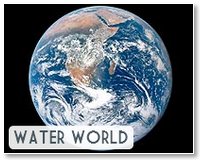| . |  |
. |
Miami FL (SPX) Feb 17, 2011 A study by scientists at the University of Miami (UM) Rosenstiel School of Marine and Atmospheric Science suggests a new way to estimate how much of the ocean's pollution is falling from the sky. The new findings can help improve scientific understanding of how toxic airborne chemicals, from the burning of fossil fuels and industrial power plants emissions, are impacting the oceans globally. By measuring Beryllium-7 (7Be) isotope concentrations in the ocean, which is found naturally throughout Earth's atmosphere, Rosenstiel School scientists David Kadko and Joseph Prospero were able to provide a method to accurately estimate rainfall in remote regions of the ocean. The two-year study measured 7Be deposited in rain collectors at two sites in Bermuda and compared these estimates to those observed in the nearby Sargasso Sea. "Over vast areas of the oceans the only rainfall data available are those made by using conventional rain collectors placed on islands," said Prospero, professor of marine and atmospheric chemistry at the UM Rosenstiel School. "However, rainfall on the island is not necessarily representative of that which falls in the surrounding ocean. Our paper shows that properly placed rain collectors on Bermuda do yield rainfall rates that agree with those determined through the 7Be measurements." Rainfall is a major pathway by which man-made airborne pollutants and other naturally occurring chemicals enter the oceans. Berrylium-7, like man-made pollutants and other naturally occurring chemicals, attaches itself to atmospheric dust particles and enters the ocean during rain events. By understanding this process, scientists can establish new ways to quantify airborne pollutants deposited to the ocean. "The accumulation of 7Be in the upper ocean provides a means of assessing 7Be deposition to the ocean on regional and global scales," said Kadko, professor marine and atmospheric chemistry of at the Rosenstiel and lead author of the study. "This then can be used to assess the deposition of other chemical species." The paper, titled "Deposition of 7Be to Bermuda and the regional ocean: Environmental factors affecting estimates of atmospheric flux to the ocean" was published in the Feb. 9 issue of the American Geophysical Union Journal of Geophysical Research.
Share This Article With Planet Earth
Related Links University of Miami Rosenstiel School of Marine and Atmospheric Science Water News - Science, Technology and Politics
 Feds still working on Asian carp problem
Feds still working on Asian carp problemMilwaukee (UPI) Feb 16, 2011 A federal official outlined for an audience in Milwaukee the government's efforts to protect endangered freshwater fisheries from the invasive Asian carp. The hearing Tuesday was part of the U.S. Army Corps of Engineers study examining ways to stop the spread of unwanted species from the Mississippi River basin into the Great Lakes, the Milwaukee Journal Sentinel reported Wednesday. ... read more |
|
| The content herein, unless otherwise known to be public domain, are Copyright 1995-2010 - SpaceDaily. AFP and UPI Wire Stories are copyright Agence France-Presse and United Press International. ESA Portal Reports are copyright European Space Agency. All NASA sourced material is public domain. Additional copyrights may apply in whole or part to other bona fide parties. Advertising does not imply endorsement,agreement or approval of any opinions, statements or information provided by SpaceDaily on any Web page published or hosted by SpaceDaily. Privacy Statement |